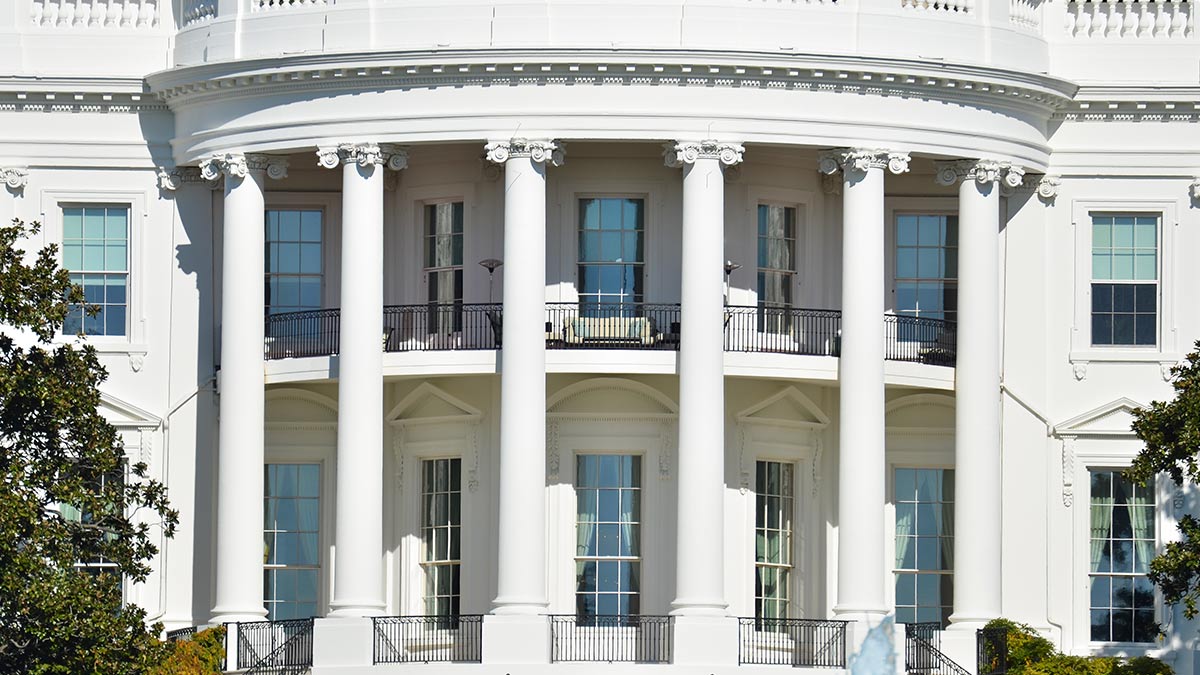
FDIC-Insured - Backed by the full faith and credit of the U.S. Government

Key takeaways
As President Joe Biden enters his third year in office, the economy is demonstrating a degree of resilience in the face of rising inflation and interest rates.
The president enjoyed some legislative successes in the first two years of his term, but his prospects may be somewhat limited in 2023 and 2024.
Federal Reserve policy, inflation’s trajectory and the debt ceiling debate will likely have the greatest influence on the economy and markets this year.
President Joe Biden is now into the second half of his current term of office. In that time, the economy has experienced periods of strong growth, then slower growth, higher inflation and rising interest rates. The jobs market has proved particularly strong, with the nation’s unemployment rate at a 50-year low.
Through this period, capital markets produced mixed results. In 2021, the stock and bond markets generated solid performance, while the U.S. economy enjoyed its strongest year of growth since 1984. However, rising inflation became a major issue, leading to a marked change in the economic environment. As the Federal Reserve (Fed) responded to the inflation threat by tightening monetary conditions, the U.S. economy slowed significantly. In response, stocks and bonds both suffered losses over the course of 2022. The volatile environment of 2022 appears to be carrying over in the early months of 2023.
During the first two years of his term, President Biden was successful at implementing a number of his legislative initiatives, though others he proposed in the early days of his term failed to gain Congressional approval. Initiatives that passed included the American Rescue Plan providing more COVID-related relief, a major infrastructure spending package (both passing in 2021) and the Inflation Reduction Act (in 2022).
While markets are always attuned to events in Washington, government policy is just one factor that impacts the direction of stocks and bonds in any given period.
A change in direction
The arrival of the Biden administration along with Democrats assuming narrow majorities in the House and Senate in 2021 marked a major change in Washington. A number of new policy proposals were put forth, with some becoming law.
In the first months of the new administration, Congress managed to narrowly pass President Biden’s $1.9 trillion COVID relief package, the American Rescue Plan. It included direct payments of up to $1,400 to most Americans, an extension of enhanced unemployment benefits, one year of direct payments to families with children and additional financial support for hard-hit businesses.
Later in 2021, a $1.2 trillion infrastructure investment package passed through Congress and was signed into law. This included $550 billion in new spending above baseline amounts that were expected to already be in place under current budgets. Most of the funding is concentrated in transportation-related projects, with some directed toward water and power projects.
More legislative roadblocks in 2022
Most major initiatives pursued by the Biden administration in 2022 languished in Congress. The logjam was broken with narrow passage of the Inflation Reduction Act, signed into law in August 2022. It included significant spending on green energy projects, gave Medicare the ability to negotiate prices on some drugs for seniors, and implemented a new minimum 15% tax on corporations. Despite its passage, the bill represented a dramatically scaled-back version of the Build Back Better package that was a major component of the Biden administration’s initial agenda.
Late in 2022, Congress passed the SECURE 2.0 Act, which provided enhancements designed to encouraged more retirement savings and protect the savings already accumulated by retirees. It also included some provisions designed to reduce the tax burden, primarily on older Americans.
In addition, President Biden was able to usher through major allocations to support Ukraine’s efforts in its war against Russia.
Most other initiatives failed to gain full Congressional approval. Notable among these were pieces of legislation designed to implement significant changes to tax laws. Importantly, the midterm elections of 2022 changed the legislative landscape going forward. While Democrats maintained narrow control of the Senate, Republicans won a slim majority in the House.
“We can expect that little will happen in the way of legislative initiatives over the second half of Biden’s term,” says Kevin McMillan, head of state and federal government relations at U.S. Bank. “Bills put forward by the Republican House will be killed in the Democratic Senate, and vice versa.” In short, the split control of Congress is not likely to result in major changes to existing government policies, meaning there will be a limited near-term impact on the markets. There may be selected pieces of legislation that will gain bi-partisan approval. Ongoing funding in support of Ukraine’s military needs may face more headwinds given the opposition expressed by some House Republicans.
Interest rates and the economy remain a major factor
Beginning in early 2022, markets focused on shifting Federal Reserve policies and the dramatic steps it took to temper the ongoing inflation threat. In March 2022, the Fed ended its so-called zero interest rate policy on the short-term federal funds rate it controls. That policy had been a boon for the markets. “Low interest rates and a policy of buying Treasury and mortgage bonds were a big support for investors,” says Rob Haworth, senior investment strategy director at U.S. Bank.
“If the Fed continues to tighten monetary policy to the point that inflation falls, it follows that we’re likely to see a decline in economic growth.”
Eric Freedman, chief investment officer at U.S. Bank
Through February 2023, the Fed raised interest rates by 4.50%, with more rate hikes expected. It also pulled back on its intervention in the bond market, ending a program of monthly bond purchases and slowly liquidating its debt security holdings. These moves were aimed at slowing the economy in order to bring down the inflation rate. While inflation appeared to peak in mid-2022, it remains at an elevated level.
“If the Fed continues to tighten monetary policy (by raising interest rates and removing liquidity from the bond markets) to the point that inflation falls, it follows that we’re likely to see a decline in economic growth,” says Eric Freedman, chief investment officer at U.S. Bank. The nation’s economy, as measured by Gross Domestic Product (GDP) grew at a rate of just 2.1% in 2022, a markedly slower pace of GDP growth than the 5.9% level achieved in 2021. A major question is whether the Fed can slow the economy without tipping it into a recession.
The stock market’s response
The markets benefited from a strong economy in 2021, the first year of the Biden administration. A healthy economy kept corporate profit growth, a major driver of stock price activity, moving in a positive direction throughout the year.
It was a different story in 2022 as ongoing inflation concerns, the Fed’s policy change and Russia’s invasion of Ukraine affected the markets. As a result, stocks declined significantly over the course of the year. The benchmark Standard & Poor’s 500 Index fell into a bear market (a decline of more 20% from the market’s peak) in June and after a brief recovery, declined into bear market territory again in late September.
Bond markets began to face pressure late in 2021 as the Fed’s policy stance shifted. Yields on the benchmark 10-year U.S. Treasury note, which were below 1% at the outset of 2021, started moving higher by the end of the year. Note that bond values decline as interest rates rise. With the Fed raising short-term interest rates and reducing its level of participation in the bond market, yields in the broader bond market moved significantly higher in 2022. 10-year Treasury yields have hovered in the 3.5% to 4.0% range in recent months.
Positioning portfolios today
It’s important to note that a number of factors contribute to market performance, and it’s not strictly a reflection of the individuals who wield positions of power in Washington. Although legislative progress may be limited, there will continue to be some focus on how lawmakers proceed in 2023. By spring, the disagreements over how to extend the nation’s debt ceiling could become a critical issue. Some Republican lawmakers are proposing significant budget cuts before voting to extend the U.S. Treasury’s ability to issue additional debt to cover already approved government expenditures. Failure to raise the debt ceiling on a timely basis could force the federal government to default on its bonds, which could result in a negative market reaction. However, when similar issues have arisen in the past (though the U.S. government has never defaulted on its debt), the market impact has been limited. “There’s no appetite by the markets to see a default on the nation’s debt,” says Haworth.
While domestic matters outside of the debt ceiling may take a back seat, international matters have gained increased attention. “Uncertainly surrounding the Russia-Ukraine war, and relations with China, are among the issues that could raise market concerns,” says Haworth.
Regardless of the legislative environment in Washington over the next two years, it’s important to keep a big-picture perspective. U.S. Bank Wealth Management investment strategists continue to anticipate slower economic growth and tighter Fed monetary policy in the early months of 2023. The economic environment could result in slower corporate earnings growth. That may result in a persistently challenging environment for asset prices.
Depending on one’s goals and time horizon, today’s investor might consider:
- An overweight position in real assets, with an emphasis on utilities, transportation, communications, midstream energy and pipelines. Economic reopening, recovering supply chains and underinvestment in energy distribution offer attractive fundamental underpinnings to a category that also provides diversified cash flows from traditional equity and fixed income.
- An overweight position in fixed income, focused on high-quality investment grade taxable and municipal bonds and dedicated exposure to short-term U.S. Treasury investments to manage risk exposure if interest rates should continue to rise.
- An underweight position in equities in both large-cap U.S. and foreign developed stocks. Continued Fed interest rate hikes, which are anticipated, could put pressure on equity markets for an extended period of time.
Regardless of how events play out, a sound strategy is to focus on a properly diversified portfolio that is attuned to your specific comfort level with investment risk.
Have questions about the economy, the markets and your finances? Your U.S. Bank Wealth Management team is here to help.
Tags:
Related articles

How far will the market correction go?
With stocks slipping in and out of bear market territory, learn how the market correction and ongoing volatility could impact your investments.

Secure 2.0 Act: How new legislation could change the way you save for retirement
The Secure 2.0 Act, signed into law at the end of 2022, may empower you to reach your savings goals sooner and offer more flexibility in retirement.
